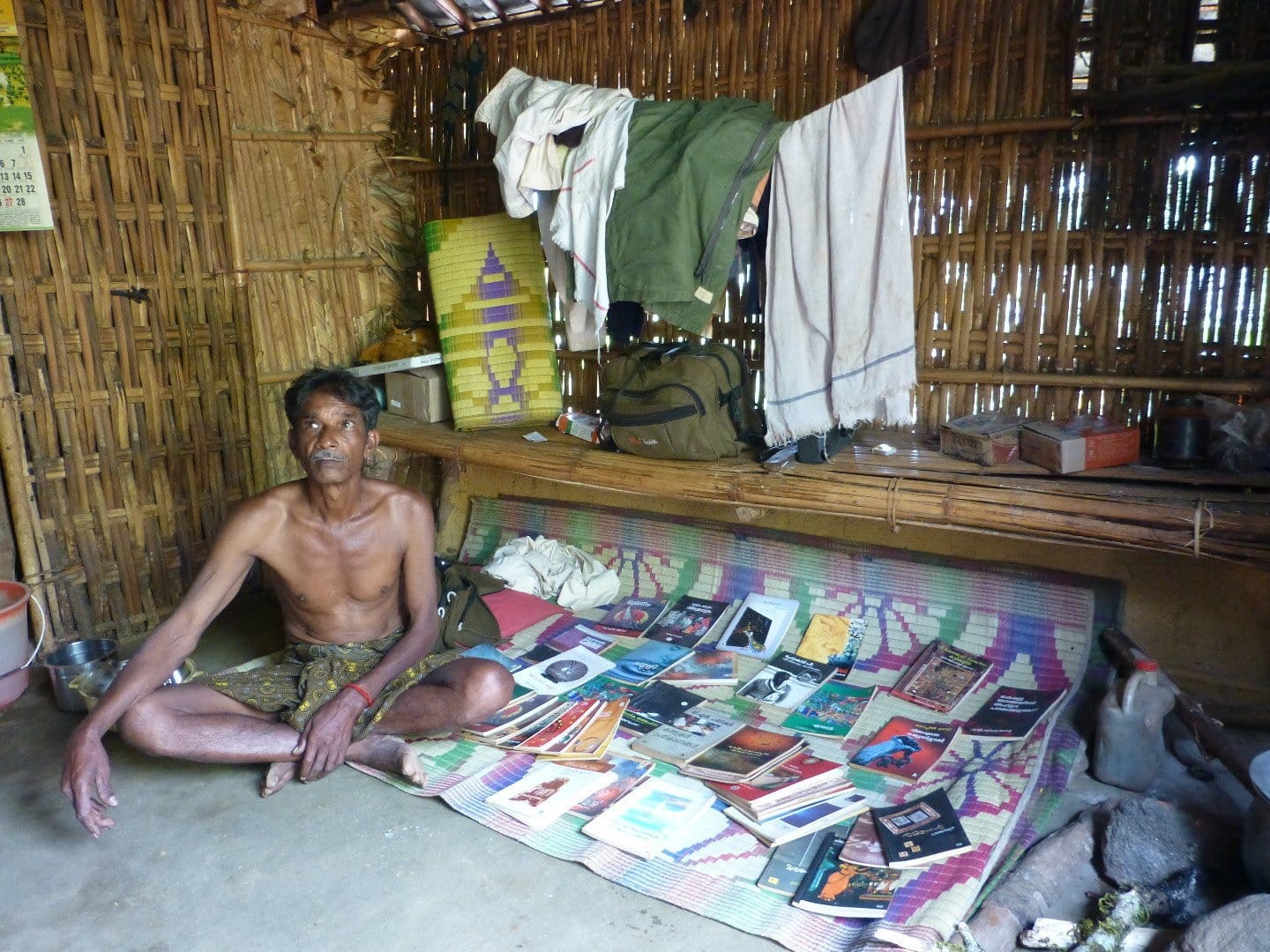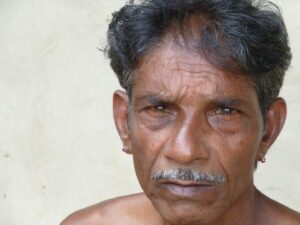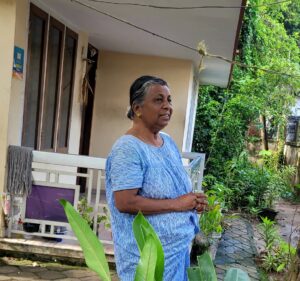The Finance Department officials in Kerala confirmed that pension payments have been pending since April this year.

Chinnathampy during the days he used to run a library at his tea shop. Today, he and his wife are dependent on Kerala's old age pension scheme. (Supplied)
The 78-year-old Chinnathampy is a resident of Kerala’s lone tribal panchayat Edamalakudy, which is located deep inside the Munnar forests of the Western Ghats in the Idukki district of the state.
He had a moments in the limelight after he found a mention in Prime Minister Narendra Modi’s Maan Ki Baat radio programme two years ago for running the remotest library in the country, and that too using a corner of his small tea shop.

Chinnathampy and his wife have not been getting their old age pensions. (Supplied)
Now, age-related ailments prevent Chinnathampy and his wife, Maniyamma, from running their little tea shop as well as the small library, which had won widespread attention as well as appreciation.
Devoid of any other sources of income, the state’s social security pension for older people became the sole means to support their expenses, especially related to health.
But the pensions are irregular, and far between, which has landed the couple in a difficult situation.
“As tribals, we get free treatment in government hospitals at Munnar and Thodupuzha. But reaching them from Edamalakudy requires hiring taxi jeeps. We have no other mode of transport available. How can we pay for the travel and food during the hospital visits, which happen at least twice a month?” asked the now 76-year-old Maniyamma, who scrapes by with the meagre amounts she occasionally gets from her three married daughters.

Gowri Kumar has not received her pension and is dependent on her daughters for survival. (George Michael/South First)
“If the pensions are regular, I can somehow manage. After the tea shop stopped functioning, we survived on the vegetables we cultivated in the home compound and rice given by our daughters. We are not demanding any increase in the pension amount. We just need its timely distribution,” Maniyamma told South First.
Similar is the situation of 67-year-old Gowri Kumar of Chembumukku in Kochi, the state’s commercial capital.
“In the last four months, I received the widow pension only once. The rest is pending as arrears,” she said.
“There was a time when the money arrived regularly in my account. Now, I am turning into a liability for my sons and relatives because I have to borrow money to meet my expenses. It’s tiring to visit ATMs in search of money and return empty-handed,” she told South First.
When contacted by South First, officials of the state Finance Department confirmed that pension payments have been pending since April this year. The ruling CPI(M) in part blames the Union government for the problem as it has drastically slashed the state’s ability to borrow money — something that could fund its welfare schemes.
In June’s second week, each beneficiary received ₹1,600 in the bank account, the arrear from March this year. The government borrowed ₹950 crore from different lending agencies just for that instalment.
The cash-strapped government is finding welfare pensions to be a liability now, and the delay in its timely release affects the morale of about 64 lakh beneficiaries, especially those aged, widowed, handicapped, and suffering from chronic illnesses.
Kerala used to boast of its welfare pensions as one of its achievements. The Union government’s welfare pension schemes targeted hardly 5.7 lakh people; the state widened its scope by adding more people and using its money to support them.
While the Union government pensions are meagre in amount, Kerala maintains a standard payment of ₹1,600 per month. On occasions like the Onam festival, the amount was released in advance so the beneficiaries would be able to celebrate such occasions.
Along with the financial struggles of the state government, what makes the welfare pension scene complex is the Union government’s decision to stop distributing them through the state government. The Centre said it started paying its share directly to the beneficiaries in their bank accounts.
“That is, in a way, good for the state. The beneficiaries would know what the actual contribution of the Centre is and how much the state adds to it,” Kerala Finance Minister KN Balagopal told South First.
He added: “Financial constraints are delaying the release of welfare pensions. We are struggling, But there is no let-up in the release. We are looking to evolve a mechanism to release the amounts in time.”
As demanded by the Centre, Kerala has already handed over the database of its welfare pension beneficiaries. Based on this database, the Union government has started paying its share to 5.7 lakh beneficiaries.
However, there are widespread complaints and confusion over the delay and procedural lapses in releasing the Centre’s share of the pensions.
In the case of Kerala’s share of the pension, Balagopal cited the cutting of the borrowing limits of the state by the Union government as the prime reason.
He accused the Centre of playing politics even with the social security of vulnerable people.
After the second Pinarayi Vijayan government came to power in 2021, there was a proposal to waive the income limit and expand the coverage of the social security pension scheme to the physically-challenged and severely ill persons.
The plan was to waive the income limit for people suffering from acute or rare diseases and those having serious mental or physical disabilities.
Now the government has put the proposal on hold because of the severity of the financial crisis the state is faced with.
Currently, 70,000-80,000 people with a critical illness or disability are members of the scheme. According to the proposal, an additional 15,000-20,000 people can join if the conditions are relaxed.
Now, because of the financial crisis, the state government decided last year to pay the pensions as a lumpsum every three or four months. Now even that is getting delayed.
Officials said the state government trying its best release all the pending instalments before Onam, as there is an existing practice of clearing all such dues before festivals.
Meanwhile, a report from the Comptroller and Auditor General (CAG) has indicated the frightening situation in Kerala: The government is just about able to manage its day-to-day expenditure, and the situation has not improved to a level where it can pay the pending dues.
In addition to the welfare pensions, the government has ₹20,000 crore liability for service pensions to its former employees.
Among the pension schemes in Kerala, the Union government contributes to the Indira Gandhi National Old Age Pension Scheme, the Indira Gandhi National Widow Pension Scheme, and the Indira Gandhi National Disability Pension Scheme.
The state government contributes most of the ₹1,600 per person per month paid under these schemes in Kerala. At the same time, the Central share is limited to “a bare minimum”, according to information available from the Finance Department.
For instance, the state government accounts for ₹1,400 of the old-age pension paid to those below 80 years and ₹1,100 to those aged above 80 years, while the Central share is limited to ₹200 and ₹500, respectively.
While the state government contributes ₹1,100 of the pension paid to those with 80 percent disability and aged less than 80 years, the Union government contributes ₹500.
In the case of pensions to those with 80 percent disability and over 80 years, the state government bears the entire expense.
In the case of pension to widows aged between 40 and 80 and those aged above 80 years, the state contributes ₹1,300, and ₹1,100, respectively, as against ₹300 and ₹500 by the Union government.
As for farm workers’ pensions and the pension provided to unmarried women above 50, the state government makes the entire contribution of ₹1,600 to each benefitiary.
There are 3,61,376 persons eligible for farm workers’ pension in the state, while the corresponding figures for the Indira Gandhi National Old Age Pension Scheme, the Indira Gandhi National Widow Pension Scheme, and the Indira Gandhi National Disability Pension Scheme are 28,50,990, 13,51,189, and 85,076, respectively.
Paying pensions to these many people is definitely a challenge for a financially hobbled state like Kerala.
And matters were only complicated when six lakh people joined the schemes when the cap on family income was raised to ₹3 lakh.
The previous UDF government raised the income bar to ₹3 lakh between July 2013 and June 2014. Most beneficiaries that enrolled during this period have an annual family income of above ₹1 lakh.
”We are appreciative of the way the state cares for us. But the delay in the releases has landed us in a difficult situation. Most beneficiaries are aged and ailing, and need to spend on medicines. In my case, I have no other source of income to support my medical expenses,” said Annakutty Dominic, a 70-year-old widow of Aluva in Ernakulam.

May 06, 2024

May 05, 2024

May 05, 2024

May 05, 2024

May 05, 2024

May 04, 2024